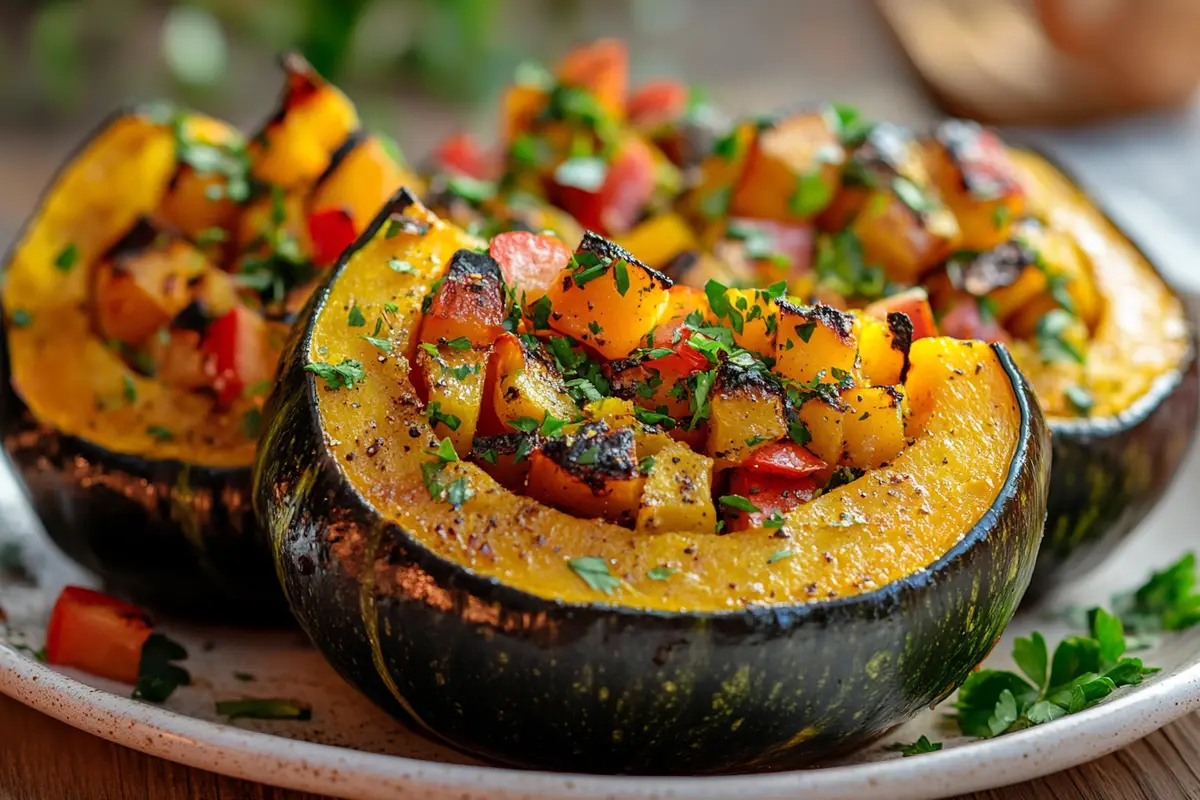Kabocha squash, often known as Japanese pumpkin, has emerged as a beloved ingredient among vegans and plant-based enthusiasts. Its naturally sweet, nutty flavor and smooth, creamy texture make it a versatile addition to countless dishes—from hearty soups and vibrant salads to comforting curries and nourishing bowls. In this comprehensive guide, we’ll delve into the nutritional benefits of kabocha squash, share an array of delicious vegan recipes, and provide practical meal prep tips to help you incorporate this seasonal superfood into your everyday cooking routine.
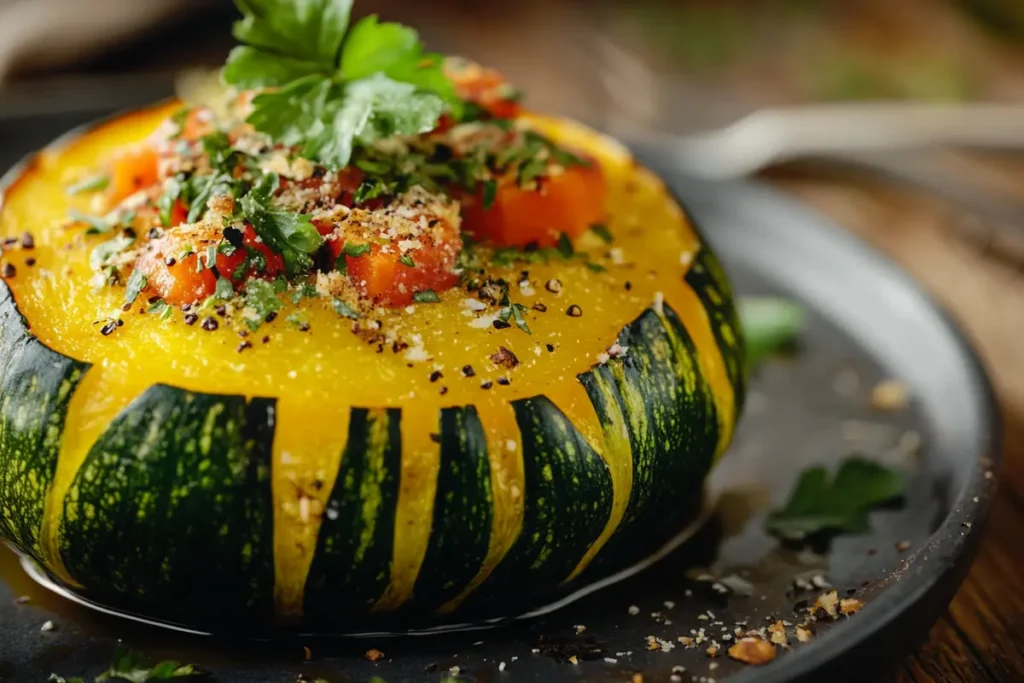
Why Kabocha Squash?
Kabocha squash has rapidly earned its place in kitchens around the world due to its versatility and delightful flavor profile. Its natural sweetness pairs beautifully with both savory and spicy ingredients, making it an ideal choice for an assortment of recipes. Whether you are preparing a quick weeknight dinner or a lavish weekend feast, kabocha squash offers a perfect balance of taste and nutrition.
For those embracing a vegan lifestyle or looking to expand their repertoire of plant-based dishes, kabocha squash is a standout choice. Not only does it add a burst of color and texture to your meals, but it also provides a range of nutritional benefits that support overall health and well-being.
Nutritional Benefits of Kabocha Squash
Integrating kabocha squash into your diet comes with a host of nutritional perks that can contribute to your health in many ways.
Rich in Vitamins and Minerals
- Vitamin A: Kabocha squash is abundant in vitamin A, which is crucial for maintaining healthy vision, supporting immune function, and promoting skin repair.
- Vitamin C: This vitamin boosts your immune system, aids in collagen production, and acts as a powerful antioxidant.
- Potassium: An essential mineral that helps regulate blood pressure and maintain proper heart function, potassium is found in generous amounts in kabocha squash.
High in Dietary Fiber
Dietary fiber is key to maintaining a healthy digestive system. Kabocha squash is an excellent source of fiber, which not only promotes healthy digestion but also helps maintain stable blood sugar levels. A fiber-rich diet can also assist in weight management and reduce the risk of chronic diseases.
Antioxidant Properties
The vibrant orange hue of kabocha squash is a clear indicator of its high antioxidant content. Antioxidants are vital in neutralizing free radicals in the body, reducing inflammation, and lowering the risk of certain diseases. This makes kabocha squash a nourishing and delicious addition to any meal.
Low in Calories, High in Flavor
Despite its rich and satisfying flavor, kabocha squash is relatively low in calories. This makes it an ideal ingredient for those looking to enjoy a hearty meal without consuming excess calories—perfect for weight loss and maintenance without compromising on taste.
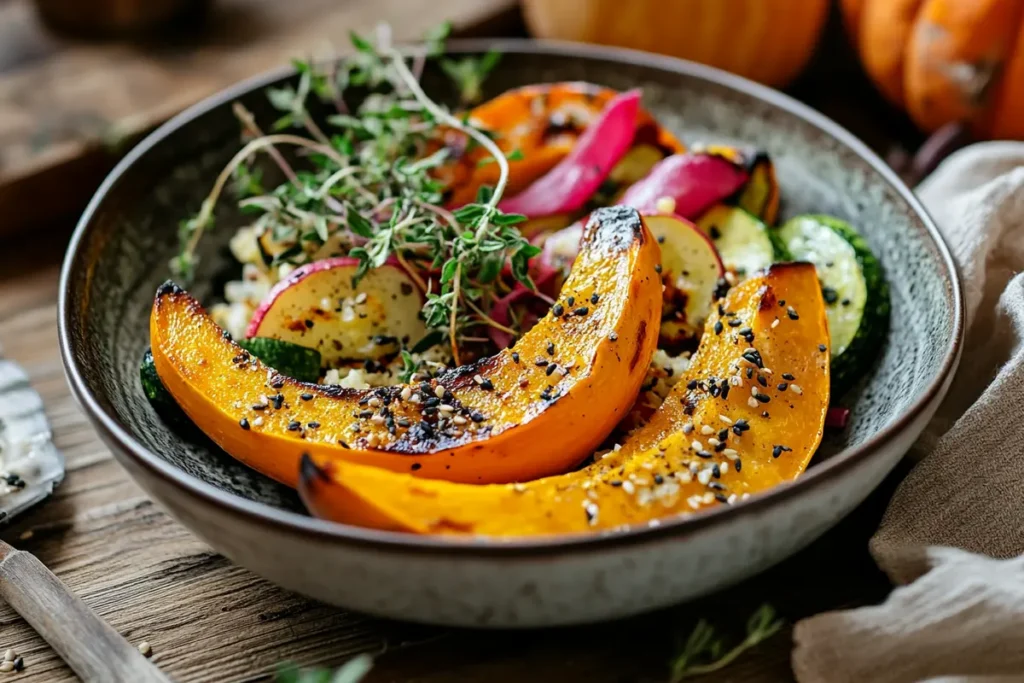
Top Vegan Kabocha Squash Recipes
Below are five creative vegan recipes that highlight the versatility of kabocha squash. These dishes are designed to be both satisfying and simple to prepare, making them perfect for busy lifestyles and meal prep.
1. Creamy Kabocha Squash Soup
Ingredients
- 1 medium kabocha squash, seeded and cubed
- 1 large onion, chopped
- 3 garlic cloves, minced
- 2 cups vegetable broth (preferably low sodium)
- 1 can coconut milk (full fat for extra creaminess)
- 1 tsp ground ginger
- 1/2 tsp turmeric
- Salt and pepper to taste
- Fresh cilantro for garnish
Instructions
- In a large pot, sauté the chopped onions and garlic until they become soft and fragrant.
- Add the kabocha squash cubes along with the vegetable broth, ground ginger, and turmeric. Bring the mixture to a boil, then reduce the heat and let it simmer.
- Allow the squash to cook until it becomes tender—this should take about 20 to 25 minutes.
- Using an immersion blender, blend the soup until it reaches a smooth, creamy consistency.
- Stir in the coconut milk, then season with salt and pepper to taste.
- Serve the soup hot, garnished with fresh cilantro and an extra drizzle of coconut milk if desired.
2. Roasted Kabocha Squash Salad
Ingredients
- 1 small kabocha squash, cut into cubes
- A mix of greens (such as spinach, arugula, and kale)
- 1/2 cup dried cranberries
- 1/4 cup toasted pumpkin seeds
- 1 apple, thinly sliced
- 2 tbsp olive oil
- 1 tbsp maple syrup
- 1 tsp apple cider vinegar
- Salt and pepper to taste
Instructions
- Preheat your oven to 400°F (200°C). Toss the kabocha cubes with olive oil, salt, and pepper, then spread them evenly on a baking sheet.
- Roast the squash in the oven for 25 to 30 minutes until the cubes are tender and slightly caramelized.
- In a large bowl, combine the mixed greens, roasted kabocha, dried cranberries, apple slices, and toasted pumpkin seeds.
- Drizzle the salad with a dressing made from maple syrup and apple cider vinegar, then toss gently to combine.
- Enjoy the salad warm or at room temperature, making it a perfect light lunch or side dish.
3. Spicy Kabocha Squash Curry
Ingredients
- 1 medium kabocha squash, peeled and cubed
- 1 large onion, diced
- 2 garlic cloves, minced
- 1-inch piece of ginger, grated
- 1 can diced tomatoes
- 1 can coconut milk
- 1 tbsp curry powder
- 1 tsp cumin
- 1/2 tsp cayenne pepper (adjust according to your heat preference)
- 1 cup chickpeas (cooked or canned, drained)
- Salt to taste
- Fresh basil or cilantro for garnish
Instructions
- In a large pot, sauté the diced onion, garlic, and grated ginger until the onions are soft.
- Add the curry powder, cumin, and cayenne pepper, stirring for about a minute to allow the spices to release their aromas.
- Mix in the cubed kabocha squash, diced tomatoes, and chickpeas. Pour in the coconut milk and bring the mixture to a simmer.
- Cover the pot and cook for 25 to 30 minutes until the squash is tender.
- Season with salt to taste, and garnish with fresh basil or cilantro before serving. This curry pairs wonderfully with rice or quinoa.
4. Kabocha Squash & Quinoa Bowl
Ingredients
- 1 cup quinoa, rinsed
- 2 cups water or vegetable broth
- 1 small kabocha squash, cubed and roasted
- 1 cup steamed broccoli florets
- 1/2 cup cherry tomatoes, halved
- 1 avocado, sliced
- 1/4 cup fresh spinach
- 2 tbsp tahini dressing (prepared by mixing tahini, lemon juice, water, salt, and pepper)
Instructions
- Start by cooking the quinoa: combine the quinoa with water or vegetable broth in a saucepan, bring it to a boil, then reduce the heat and let it simmer until the liquid is fully absorbed (approximately 15 minutes).
- Roast the kabocha squash cubes as described in the roasted salad recipe.
- In a large bowl, assemble the quinoa, roasted squash, steamed broccoli, cherry tomatoes, avocado slices, and fresh spinach.
- Drizzle the tahini dressing over the bowl and toss lightly to mix all the flavors.
- Serve immediately for a nourishing meal that’s perfect for lunch or dinner.
5. Savory Kabocha Squash Stir-Fry
Ingredients
- 1 small kabocha squash, julienned or thinly sliced
- 1 red bell pepper, thinly sliced
- 1 cup snap peas
- 1 carrot, julienned
- 2 garlic cloves, minced
- 1 tbsp grated ginger
- 2 tbsp soy sauce or tamari (for a gluten-free version)
- 1 tbsp sesame oil
- 1 tsp rice vinegar
- 1 tsp maple syrup
- Sesame seeds for garnish
- Fresh scallions for garnish
Instructions
- Heat the sesame oil in a large skillet or wok over medium-high heat.
- Add the minced garlic and grated ginger, stirring briefly until they become aromatic.
- Toss in the kabocha squash, red bell pepper, snap peas, and carrot. Stir-fry the vegetables for about 8 to 10 minutes until they are tender yet still crisp.
- Pour in the soy sauce, rice vinegar, and maple syrup, tossing the vegetables so that each piece is evenly coated with the sauce.
- Garnish with sesame seeds and fresh scallions before serving over steamed rice or noodles.
How to Choose and Prepare Kabocha Squash
Before you start cooking, it’s important to select and prepare your kabocha squash correctly to ensure the best results in your dishes.
Selecting the Perfect Squash
- Appearance: Choose a kabocha squash with a deep, matte skin and a firm texture. The skin should have a slightly rough surface, and the color can vary from dark green to deep orange.
- Weight: Heavier squash usually indicates a dense, moist interior, which means a richer flavor.
- Sound: Give it a gentle tap. A hollow sound typically indicates that the squash is mature and ready to use.
Preparation Tips
- Washing: Always wash your squash thoroughly to remove any dirt or residue before cutting.
- Cutting: Use a sharp knife and a stable cutting board. Depending on the recipe, you can either peel the squash or leave the skin on—especially if you plan to roast it.
- Roasting: Roasting brings out the natural sweetness of kabocha squash. Simply toss the cubes with olive oil, salt, and pepper, and roast at 400°F (200°C) for about 25 to 30 minutes until tender.
Following these simple tips will save you time in the kitchen and help ensure that your dishes come out perfectly every time.
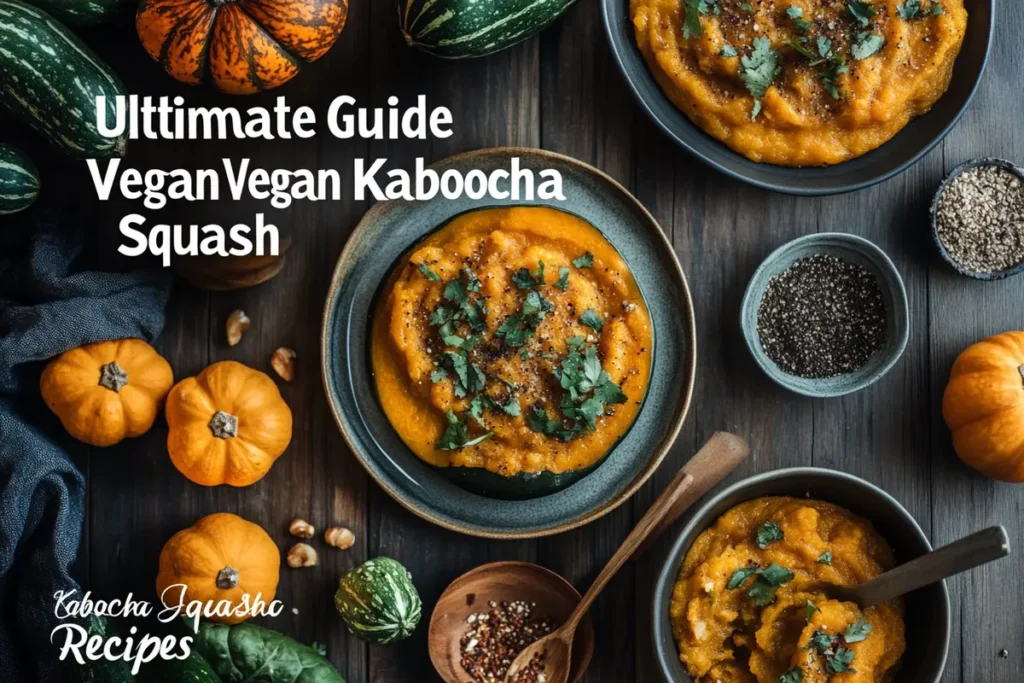
Vegan Meal Prep Ideas with Kabocha Squash
Meal prepping is an excellent way to incorporate kabocha squash into your weekly routine. With a bit of planning, you can enjoy nutritious, ready-to-eat meals that are both delicious and satisfying.
Batch Cooking
- Roast in Bulk: Prepare a large batch of roasted kabocha squash cubes at the beginning of the week. Store them in airtight containers for easy access when assembling salads, bowls, or soups.
- Cook Grains in Advance: Grains like quinoa, brown rice, or barley can be cooked in bulk and paired with your kabocha dishes for a well-balanced meal.
- Freeze Portions: Many kabocha-based recipes, such as soups and curries, freeze well. Consider preparing double batches and freezing half for a quick meal on a busy day.
Quick Assembly Ideas
- Salad Jars: Layer roasted kabocha with fresh vegetables, grains, and a light dressing in mason jars. These portable salads are perfect for a grab-and-go lunch.
- Buddha Bowls: Combine a base of greens or grains with roasted squash, raw or steamed vegetables, and a drizzle of your favorite dressing for a nutrient-packed meal.
- Wraps and Sandwiches: Use mashed roasted kabocha mixed with avocado and spices as a unique spread for wraps or sandwiches, adding a creamy and flavorful twist.
Time-Saving Tools
- Slow Cooker: A slow cooker is ideal for creating hearty kabocha soups or curries. Simply add your ingredients in the morning, and come home to a warm, ready-to-eat meal.
- Instant Pot: If you’re short on time, an Instant Pot can significantly reduce cooking times while preserving the squash’s natural flavors and nutrients.
Incorporating Kabocha Squash into a Balanced Vegan Diet
Kabocha squash is not only a seasonal treat—it’s a versatile ingredient that fits perfectly into a balanced vegan diet. Here are some ways to make the most of its benefits:
Diversify Your Nutrient Intake
- Protein Pairings: Enhance your meals by pairing kabocha recipes with protein sources such as lentils, chickpeas, or tofu to create a well-rounded dish.
- Healthy Fats: Incorporate healthy fats like olive oil, avocado, or nut butter. These fats help in the absorption of fat-soluble vitamins and add depth to your meals.
- Whole Grains: Complement your kabocha dishes with whole grains such as quinoa or brown rice. This not only boosts fiber content but also provides long-lasting energy.
Seasonal Adaptations
- Fall and Winter Favorites: During cooler months, dishes like soups, curries, and stews that include kabocha squash offer warmth and comfort.
- Summer Variations: In warmer weather, try using lightly roasted kabocha in salads or chilled grain bowls for a refreshing twist.
By balancing your meals with a variety of nutrient-rich ingredients, you can enjoy both the taste and health benefits of kabocha squash throughout the year.
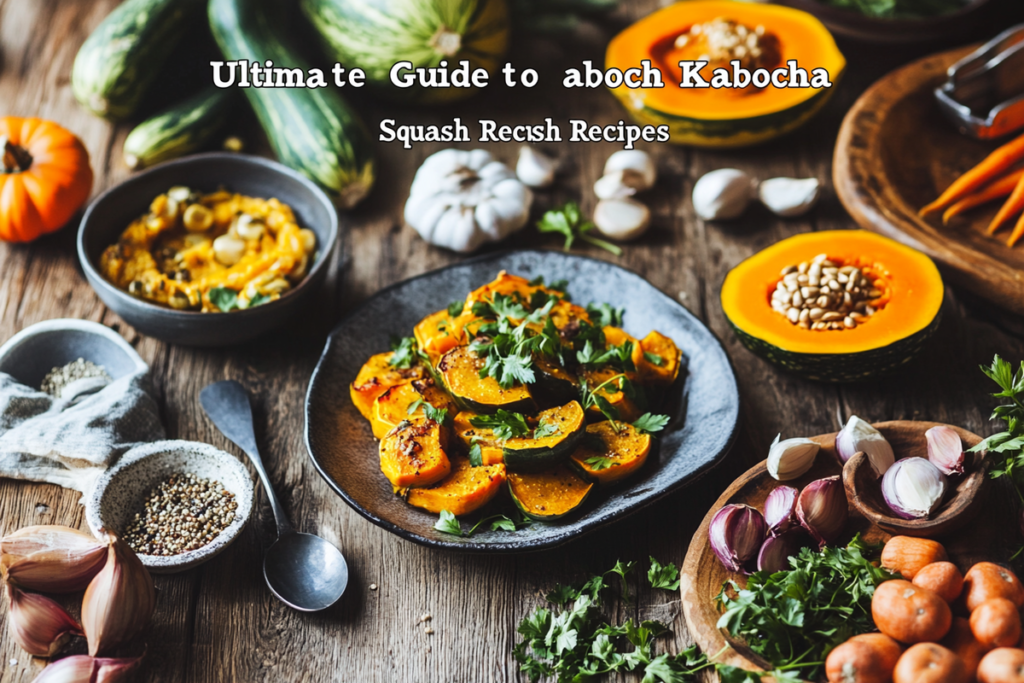
FAQs About Kabocha Squash
Q: What is kabocha squash?
A: Kabocha squash is a type of winter squash prized for its sweet, nutty flavor and vibrant orange flesh. It’s a versatile ingredient used in both savory and sweet dishes.
Q: How do I store kabocha squash?
A: Whole kabocha squash should be stored in a cool, dark, and dry place. Once cut, wrap the pieces in plastic wrap and refrigerate for up to a week. Roasted cubes or prepared dishes can also be frozen for longer storage.
Q: Can I eat the skin of kabocha squash?
A: Yes, the skin of kabocha squash is edible, especially when roasted. However, if you prefer a smoother texture in soups or purees, you can peel it before cooking.
Q: Are there other vegan recipes that feature kabocha squash?
A: Absolutely! In addition to the recipes provided above, you can explore making kabocha risotto, stuffed kabocha squash, or even a dessert like kabocha pie. The versatility of this squash means you can experiment with both sweet and savory creations.
Q: Is kabocha squash gluten-free?
A: Yes, kabocha squash is naturally gluten-free, making it an excellent choice for those with gluten sensitivities or celiac disease.
Conclusion
Kabocha squash is an extraordinary ingredient that brings a burst of flavor, vibrant color, and a host of nutritional benefits to any vegan kitchen. Whether you’re preparing a creamy soup, a hearty salad, a spicy curry, or a nourishing bowl, kabocha adds a unique texture and natural sweetness that elevates your meals to a new level. Its versatility, ease of preparation, and impressive nutrient profile make it a perfect choice for anyone looking to embrace a healthy, plant-based lifestyle.
Incorporating kabocha squash into your weekly meal planning can help boost your intake of essential vitamins, antioxidants, and fiber—all while delighting your palate with a variety of delicious dishes. The recipes provided in this guide are just the beginning. Feel free to experiment with different flavor combinations, adapt the recipes to suit your taste, and share your culinary creations with friends and family.
Whether you’re a seasoned vegan or just beginning to explore plant-based options, these kabocha squash recipes offer a nutritious and satisfying way to diversify your meals. Enjoy the process of cooking and the journey of flavor exploration, and let kabocha squash become a cherished staple in your kitchen.
Happy cooking and healthy eating!
